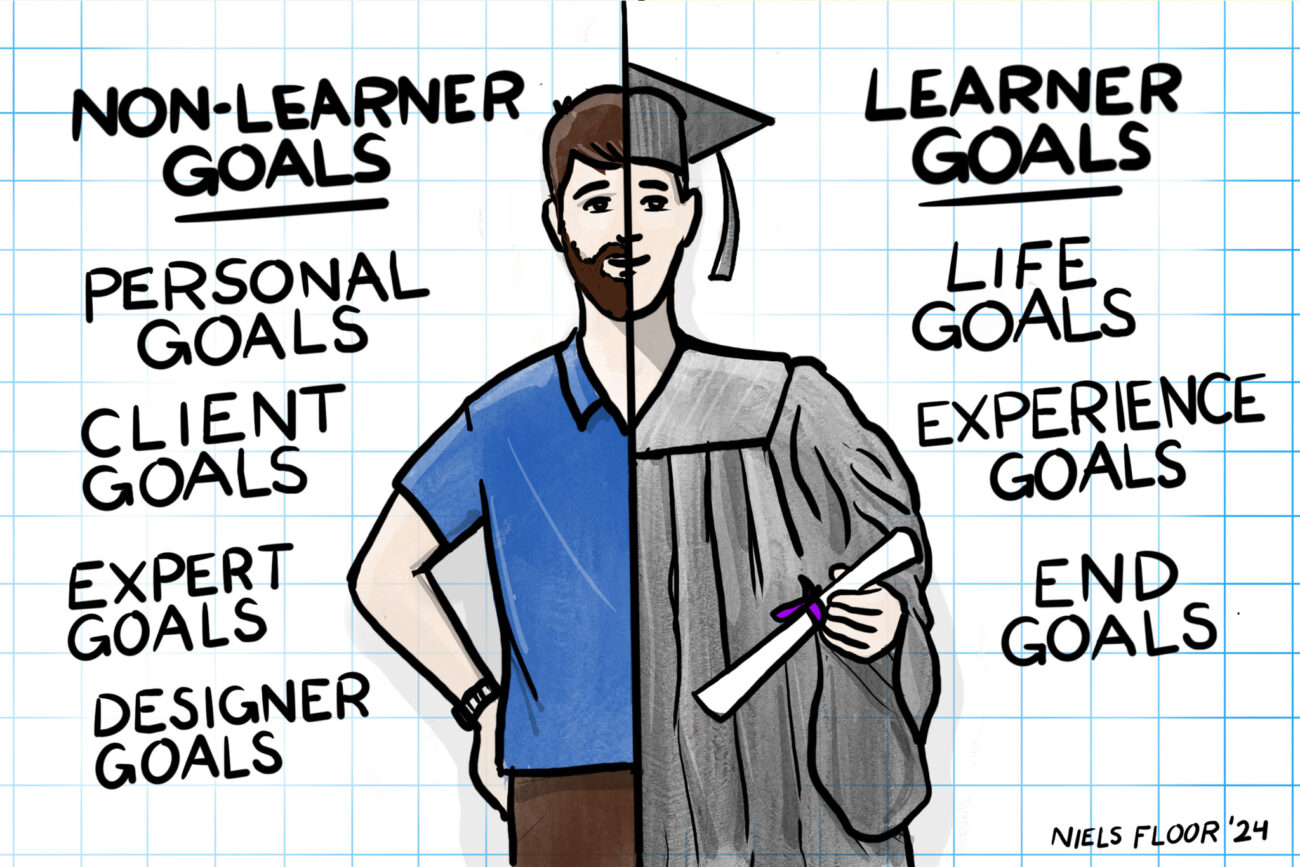February 12 2024 – Niels Floor |
How do you ensure learners reach their goals? And how do you know if these goals are relevant for the learner? To answer these questions, it’s smart to take a good look at goal-oriented design.
“Learning experience design (LXD) is the process of creating learning experiences that enable the learner to achieve the desired learning outcome in a human-centered and goal-oriented way.“ – Niels Floor
A learning experience is senseless if learners don’t reach their goals. Enabling learners to reach a desired learning outcome requires goal-oriented design. It’s not a coincidence that goal oriented design is part of the definition of LXD.
Interaction design roots
Goal-oriented design (or goal-directed design) was developed by interaction design pioneer Alan Cooper, as described in his book About Face: the essentials of interaction design, he noticed a focus on features in software development. The misconception is that if you add all the features people ask for, they will be happy. Cooper understands that a great user experience goes beyond adding features and requires clear goals for your design.
This approach is vital to interaction design, and goal-oriented design for learning experience design is just as important. The goals are different, but the principle remains the same. It can help solve many common problems that negatively impact the experience of the learner. A classic example is when clients or subject matter experts think adding more content will automatically improve the learning experience. Of course, this tends to have an adverse effect. That’s why learning experience design cares less about content and more about people and their goals.
When you design a learning experience, it’s easy to lose track of the desired learning outcome during the creative process. When ideas are flowing, and opportunities seem endless you can slowly drift away from the original intentions of your design. Having a goal-oriented approach ensures you keep coming back to why you are creating this learning experience in the first place.
Types of goals
Not all goals are the same. In fact, being able to distinguish between different (types of) goals is vital for designing a great learning experience. Traditionally, there is a focus on learning related goals, also known as learning objectives. But there are other goals to keep in mind that can be just as, or even more important.
Alan Cooper distinguishes different types of goals that I’ve adapted slightly to work perfectly for LXD:
- User goals (which I will refer to as learner goals)
- Non-user goals (which I will refer to as non-learner goals)
Let’s take a closer look.
Learner goals

Picture by Andrea Piacquadio
To serve learners well, it’s important to know what kind of goals will get them where they want to be in life. Both in the short run as in the long run. There are three types of goals that are specific to what learners want to achieve:
- Life goals
- Experience goals
- End goals
Each of these types of goals has unique characteristics, let’s explore them one by one.
Life goals
The goals we have as learners go beyond taking a course or attending a webinar. Our life goals represent what we are passionate about and motivate us to take action. It’s why learners do the things they do, for example:
- Become an expert in your field.
- Lead a company that is good for people, planet, and profit.
- Produce products people love to use.
- Share your expertise by writing a book.
Any learning experience you design is related to these life goals, whether you know it or not. If your learners don’t see any connection between their life goals and the outcome of your design, it will lose relevance for the learner. If there is a clear connection, it will motivate learners greatly. Achieving my life goal of writing my book “This is Learning Experience Design” would not have been possible without a having a multitude of learning experiences over a period of nearly fifteen years. You can imagine how an inspiring talk, enlightening video or meaningful conversation would get me fired op to continue writing and work on this life goal.
Experience Goals
What kind of experience do you want to offer to your learners? The possibilities are endless from short and simple to long and challenging. It’s smart to set experience goals that describe key qualities of the experience. For example, a goal can be to create a safe environment where learners feel at ease, and they are not afraid to speak out or make mistakes. Designing the right circumstances for learners to feel good and do well can be one of the main goals of your design. If you lose sight of that goal, it will impact everything else you design. Here are a couple examples of experience goals:
- Feel a sense of belonging.
- Not get frustrated with technology.
- Have a good time with my fellow student.
- Get challenged mentally and physically.
By formulating experience goals at the start of your design process, you ensure your design works out the way it is intended to. If you don’t, the experience is more or less out of your hands and you may not be pleased with the results.
End goals
An end goal is the tangible outcome of a learning experience. It’s what the learner gets out of the experience. Learning objectives can be formulated as end goals, for example:
- Know all countries and capitals in Africa.
- Handle classified documents properly.
- Write a thesis on the downfall of the Roman empire.
- Deliver engaging presentations.
It’s obvious that end goals should be part of your learning objectives. Remember that learning objectives aren’t just about knowledge and skills, they also relate to insights and behaviour.
Combining learner goals
In a meaningful learning experience these three types of goals come together. That’s why it’s important to relate your learning outcome to life goals, experience goals, and end goals. If you leave out one of these types, you won’t be able to focus on all that matters to the learner and the experience will fall short.
Non-learner goals

Picture by Emma Bauso
Let’s be clear: learner goals are the primary goals of any learning experience. There are other goals that also matter and should not be forgotten. These are the four types of non-learner goals:
- Personal goals
- Client goals
- Expert goals
- Designer goals
What’s interesting about non-learner goals, is that they represent different perspectives. Depending on the situation, you could be dealing with goals from different stake holders. Bringing their perspectives together and aligning their goals can be challenging and requires careful attention.
Personal goals
People are more than learners. Being a learner is part of what we do and who we are as human beings but not all there is to us. A participant in a workshop actively takes on the role of a learner, but can also be a colleague, parent, entrepreneur, partner, volunteer, athlete, musician and so on. If you only focus on the role of leaner, you’re missing out on a big chunk who your learners are and what matters to them, for example:
- Spend more time with your kids.
- Run a marathon.
- Offer help to homeless people in your city.
- Record an album with your band.
These personal goals can be great hooks for your design. If you can connect learner goals with personal goals, it will boost engagement.
Client goals
Sometimes the goals of the client and the goals of the learner don’t overlap. They can even be contradicting. For example, a client wants to use new software that is cheaper to purchase but harder to use. The employees need to learn how to use software they don’t want to use. As a result, it will decrease productivity, lower moral and cost more money. As a LX designer, offering advice to a client can also mean not giving them what they want.
- Change the company culture.
- Grow revenue.
- Improve the service level.
- Implement a new strategy.
Keeping the client happy is always a good idea. However, this shouldn’t take away from keeping the learner happy. If client goals and learner goals oppose, advocate for the perspective of the learner as they are our primary focus.
Expert goals
LX designers frequently work with subject matter experts (SME’s). There’s a general assumption that subject matter experts think everything about their expertise is important. Of course, that’s not always the case, but you can imagine experts having different goals than learners. Experts might focus on:
- Including specific content
- Doing justice to the subject
- Separating main issues from side issues
- Unlearning incorrect knowledge.
To collaborate effectively with SME’s, you could explain the concept of goal-oriented design to them. This can broaden their perspective and support a more human-centered approach.
Designer goals
Finally, there’s you, the designer. What are your goals? Your work impacts people and the world around them. There is a responsibility designers have to do the right thing. Unfortunately, there are enough examples where design is used in unethical ways. For example, social media platforms are designed to be addictive and are proven to decrease well-being among large groups of users. You have the opportunity to set better goals, like:
- Having a positive impact on the environment.
- Offering inclusive experiences where everyone can participate.
- Push your creative boundaries and always make your next design better than the last one.
- Advocate for the learner.
The importance of ethical design cannot be overstated. Always think about how your choices will affect others and act accordingly. By including designer goals it ensures you try to do better.
Conclusion
Alan Cooper provides great insights into what types of goals can be distinguished and why they matter. In education, there can be an unhealthy focus on learning objectives, described here as end goals. This leaves out all other goals including personal goals and life goals. In corporate learning, there tends to be a focus on client goals. This is even more problematic as it isn’t learner centered and limits your goals dramatically. Adopting this goal-oriented approach makes a lot of sense for multiple reasons as goal-oriented design for learning experience design helps to:
- Distinguish between different types of goals, like learner goals and non-learner goals.
- Keep an eye on the overall learning
- Formulate learning objectives and other goals that align with the outcome of the learning experience.
- Understand that adding content or functionality will not automatically improve your design.
- Identify how different types of goals can be aligned.
- Not letting the functionalities of the technology you use determine the choices you make for your design.
There is overlap between human centered design and goal-oriented design. The methods used to design in a human centered and goal-oriented way are similar, but the focus is different. Keeping the people you design for and their goals at heart will improve any learning experience.

